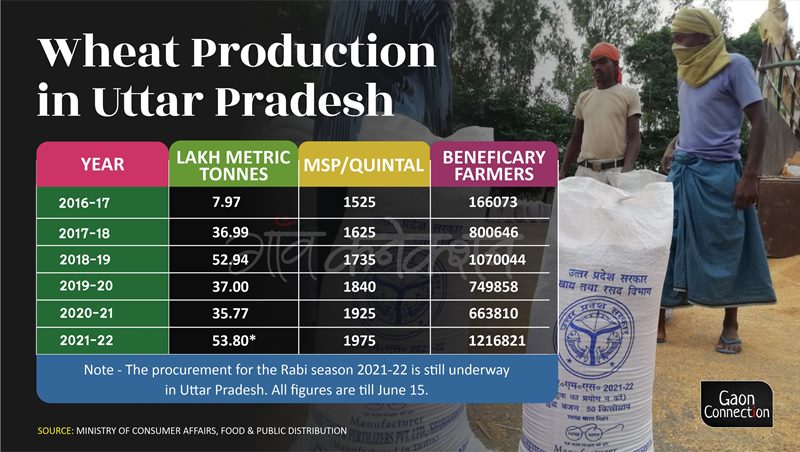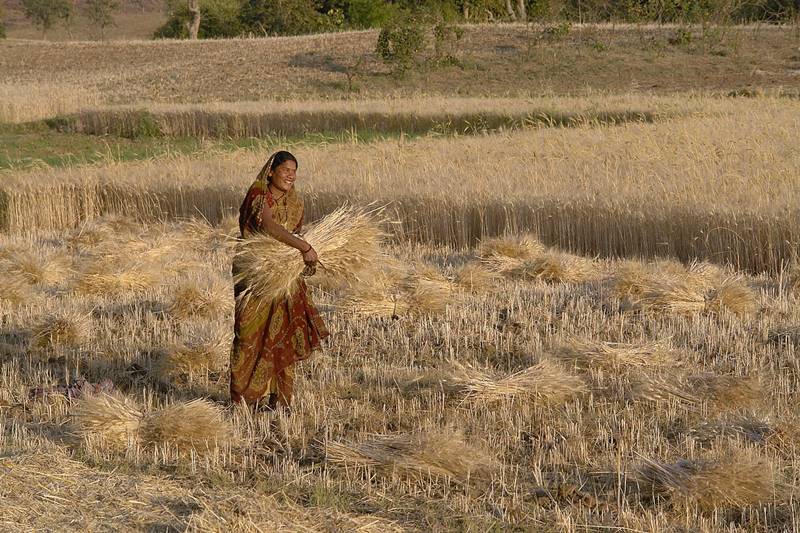Seven-fold increase in wheat procurement in Uttar Pradesh in the past 4 years. But, why is it still not enough?
Although the procurement of wheat harvest in Uttar Pradesh till June 15 this year is seven times more as compared to 2016-17, it still accounts for only 14% of the total wheat production in the state. More details here.


The assembly election-bound state has procured about 14 per cent of this year’s total wheat production.
The Uttar Pradesh government had procured a total of 5.38 million metric tonnes of wheat till June 15 in 2021-22, which is a record in itself. The procurement, which has been done at a minimum support price (MSP) of Rs 1,975 per quintal, is 33 per cent higher than last year and 700 per cent higher than the produce procured in 2016-17.
“Uttar Pradesh has recorded the highest ever wheat procurement since independence, which is a record in itself. From 2018-18 the state government had collected 52.92 lakh tonnes of wheat valued at Rs 9231.99 crores from 11,27,195 farmers,” Uttar Pradesh Agriculture Minister Surya Pratap Shahi said.
Shahi also remarked that the present procurement is seven times higher than in 2016-2017 during former Chief Minister Akhilesh Yadav’s tenure.
Less than what meets the eye
However, looking at these numbers with respect to the size, total production and number of farmers in the state, it shows that the numbers shouldn’t really be a reason to celebrate. The assembly election-bound state has procured about 14 per cent of this year’s total wheat production.

Also Read: Rains spoil tonnes of wheat at govt purchasing centres in Madhya Pradesh. Yet again.
In comparison, the states of Punjab and Haryana procure almost 70 per cent to 80 per cent of their total production at MSP.
Uttar Pradesh is India’s largest wheat-producing state, accounting for around one-third of overall wheat production. Yet, it lags behind the states of Punjab, Haryana and Madhya Pradesh when it comes to procurement.
Explaining the reasons behind it, Mohali-based agriculture expert Devinder Sharma told Gaon Connection that it is due to the superior procurement mechanisms of these states vis a vis Uttar Pradesh.
“On an average, 80-85 percent of the overall production of wheat and paddy in Punjab is procured by the government,” Sharma stated.

Also Read: In the line of fire, thousands of hectares of standing crops
“Because the mandis and procurement system are superior in Punjab, wheat producers from Uttar Pradesh and Bihar regularly go to Punjab and Haryana to sell their harvest. Why would they need to go to Punjab if the system was functioning correctly in UP and Bihar?” he added.
Till June 15, the Uttar Pradesh government had procured 53.80 lakh metric tonnes of wheat from about 1.2 million farmers during the rabi marketing season 2021-22.
More farmers in UP, yet less beneficiaries from Punjab/Haryana
According to figures from the Union Ministry of Consumer Affairs, Food and Public Distribution, 42.877 million metric tonnes (MT) of wheat was procured throughout the country as of June 15.

Punjab ranks first with 13.21 million MT in this category, while Uttar Pradesh ranks fourth with 5.403 million MT. Even though Madhya Pradesh and Haryana produce less wheat, they are ahead of Uttar Pradesh . Punjab produced 18.207 million metric tonnes of wheat in 2019-20, of which 12.714 million metric tonnes were procured during the rabi procurement season 2020-21.
In UP, however, only 3.57 million MT was procured, compared to 32.089 million MT of production .
Also Read: Why govt’s decision to import pulses worries farmers, traders
When we look at the number of farmers who benefited from the procurement, UP falls short again.
According to Food Corporation of India (FCI), 4.768 million farmers across the country benefited from procurement at MSP till June 14.
Around 1.7 million (1,724,218) such farmers were from Madhya Pradesh and Uttar Pradesh procuring wheat from about a million (1,006158) farmers. Punjab bought wheat from 883, 078 farmers while Haryana procured wheat from 760,639 farmers.
However, in terms of the number of farmers and farm holdings, all three states trail UP.

“It is remarkable that the procurement grew compared to the previous years. However, the figure is tiny if we compare total production, farmers, and the population of the states. The government can procure at least 80 tonnes of wheat if it plans and operates efficiently, Arvind Kumar Singh, senior journalist and rural affairs expert, told Gaon Connection.
Also, Kaushambi-based Chaudhary Pushpendra Singh, President of the Kisan Shakti Sangh said, “If Punjab and Haryana sell 70-80 per cent of their entire wheat at MSP, why is it merely 15 per cent in Uttar Pradesh?” Why are farmers in Uttar Pradesh obliged to sell wheat in the open market for Rs 1500-1700 a quintal?”
According to the Department of Agriculture of Uttar Pradesh government, nearly 23.3 million farmers benefit from the Pradhan Mantri Kisan Samman Nidhi Yojana (a farmer welfare scheme). As per the eighth instalment of the PM Kisan Yojana, the scheme has helped 1.7 million farmers in Punjab. Although not all farmers sow wheat, wheat and paddy are grown by a sizable population Uttar Pradesh and majority of these farmers do not benefit from MSP procurement by the government.
How many farmers benefit from MSP?
According to a report by the NITI Aayog released in January, 2016, only 6 per cent of the farmers across India benefit from government’s procurement at MSP.
Also, in response to a question in the Rajya Sabha on September 18 2020, Rao Saheb Danve Patil, Minister of State in the Ministry of Consumer Affairs, Food and Public Distribution, stated that 4.333 million farmers benefited from the MSP in the Rabi season 2020-21 until September 9. When 1.049 million beneficiary farmers (1,049,982) from Punjab and 780962 farmers from Haryana are added up, it comprises 42 per cent of the total farmers benefiting from MSP in the country.

